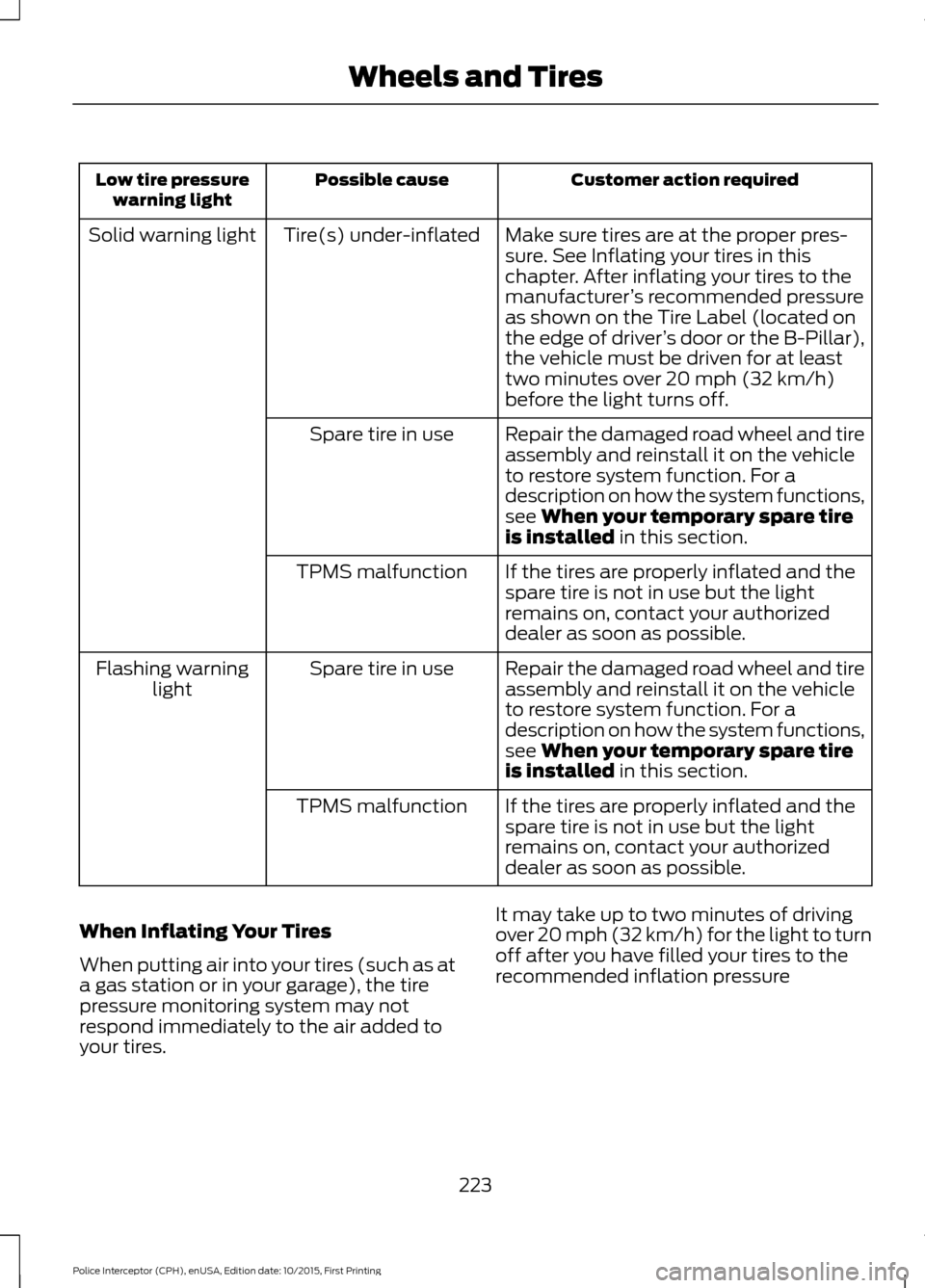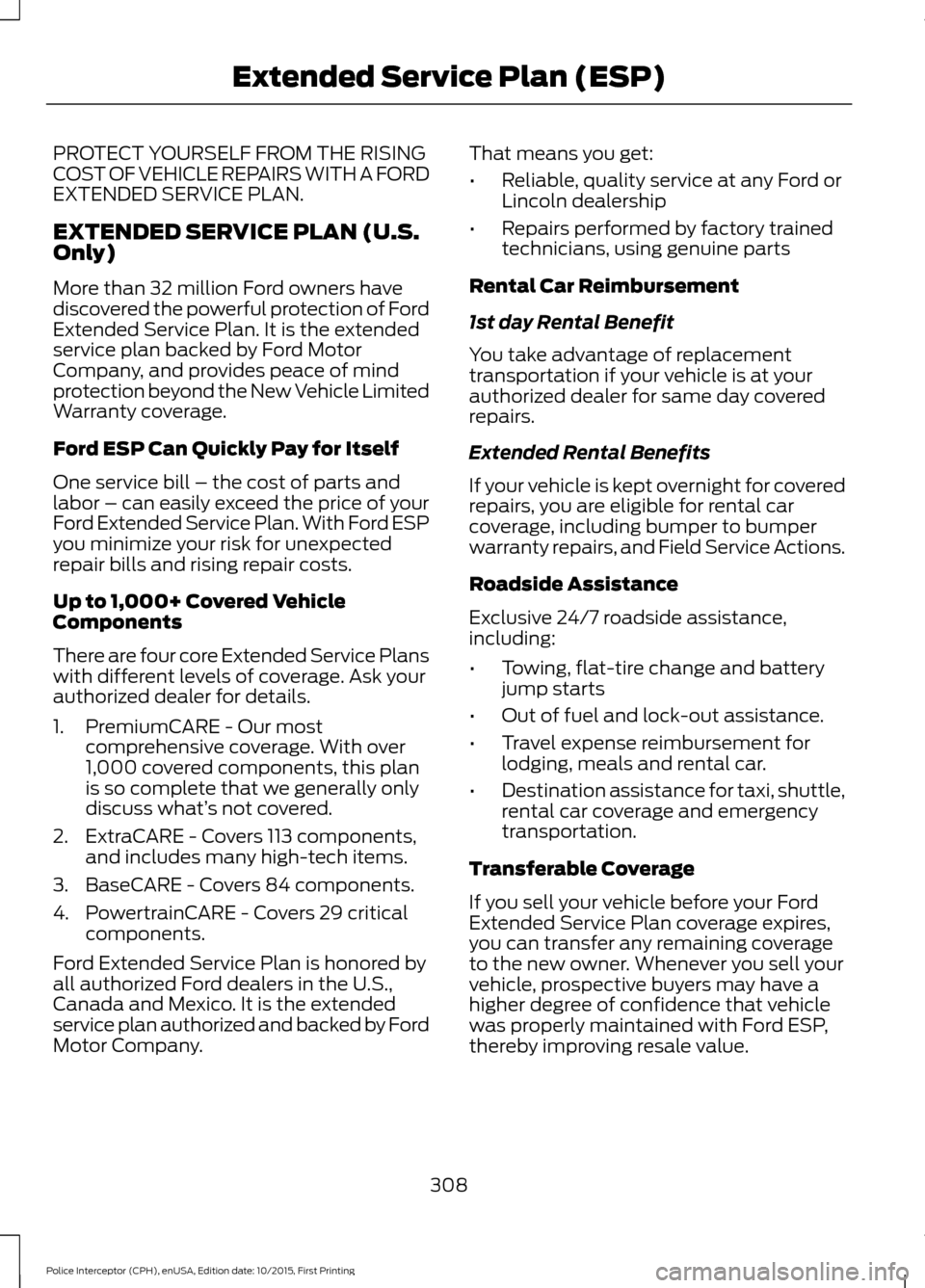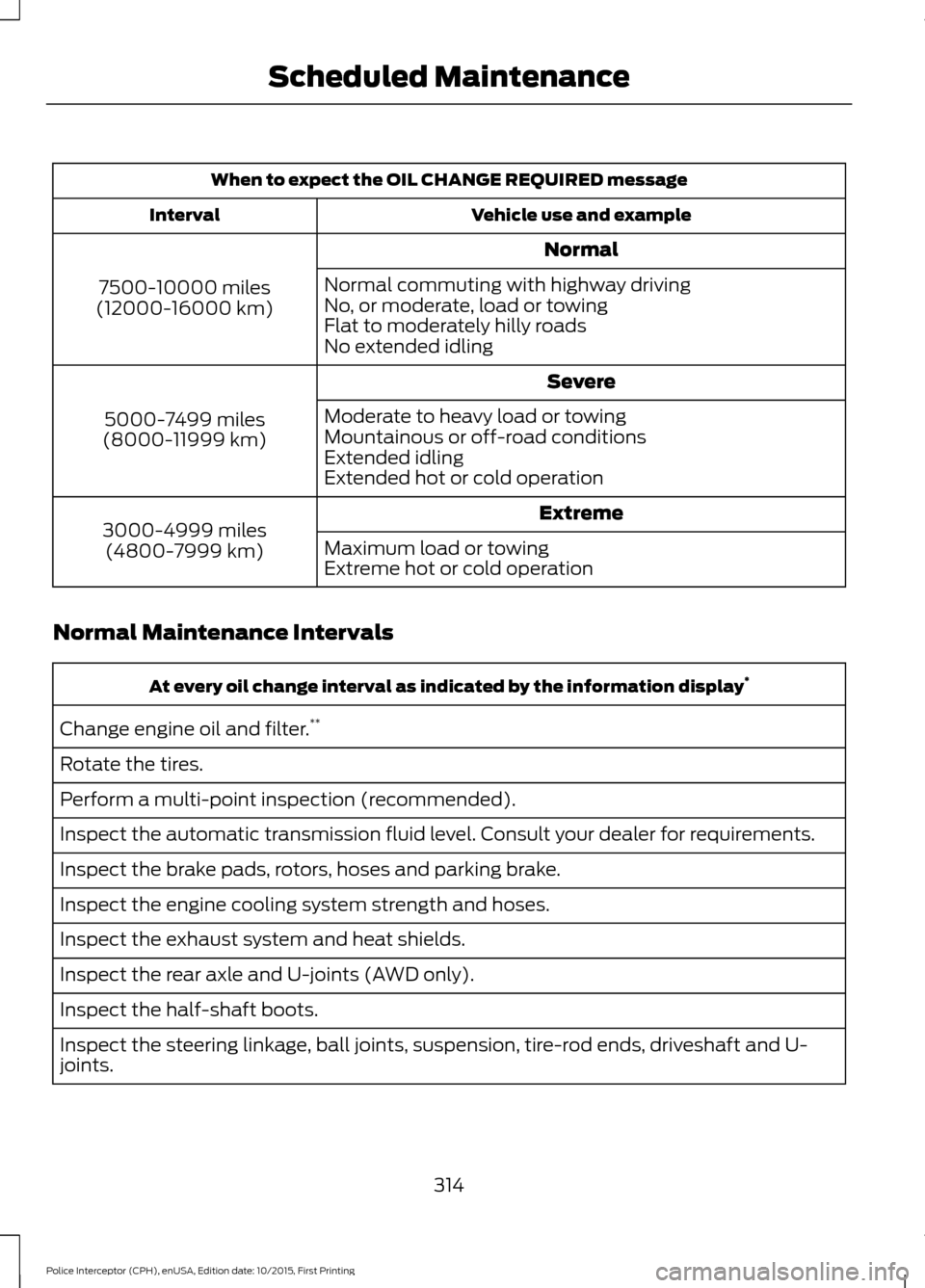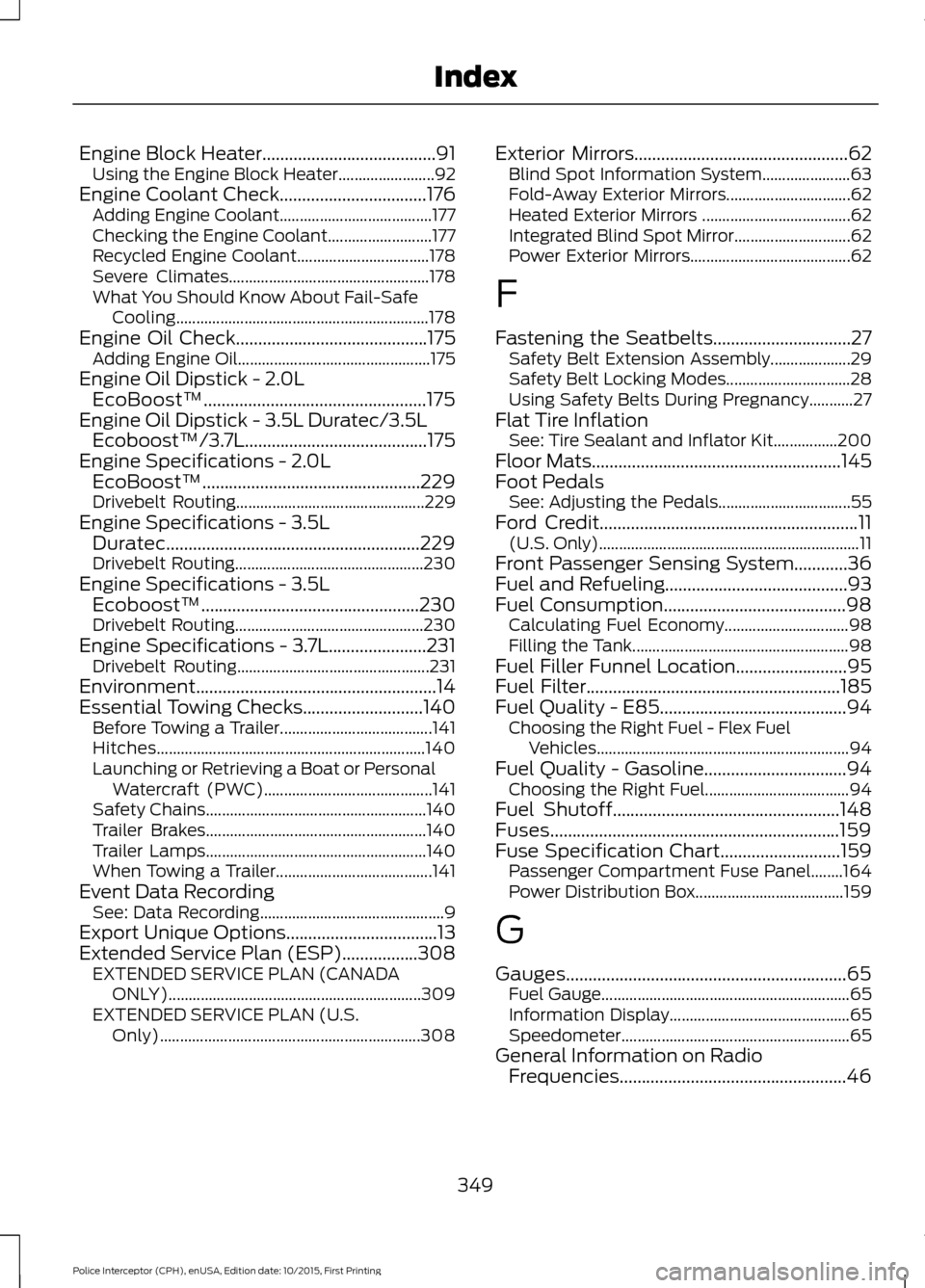2016 FORD POLICE INTERCEPTOR SEDAN flat tire
[x] Cancel search: flat tirePage 226 of 358

Customer action required
Possible cause
Low tire pressure
warning light
Make sure tires are at the proper pres-
sure. See Inflating your tires in this
chapter. After inflating your tires to the
manufacturer’s recommended pressure
as shown on the Tire Label (located on
the edge of driver ’s door or the B-Pillar),
the vehicle must be driven for at least
two minutes over 20 mph (32 km/h)
before the light turns off.
Tire(s) under-inflated
Solid warning light
Repair the damaged road wheel and tire
assembly and reinstall it on the vehicle
to restore system function. For a
description on how the system functions,
see When your temporary spare tire
is installed in this section.
Spare tire in use
If the tires are properly inflated and the
spare tire is not in use but the light
remains on, contact your authorized
dealer as soon as possible.
TPMS malfunction
Repair the damaged road wheel and tire
assembly and reinstall it on the vehicle
to restore system function. For a
description on how the system functions,
see
When your temporary spare tire
is installed in this section.
Spare tire in use
Flashing warning
light
If the tires are properly inflated and the
spare tire is not in use but the light
remains on, contact your authorized
dealer as soon as possible.
TPMS malfunction
When Inflating Your Tires
When putting air into your tires (such as at
a gas station or in your garage), the tire
pressure monitoring system may not
respond immediately to the air added to
your tires. It may take up to two minutes of driving
over 20 mph (32 km/h) for the light to turn
off after you have filled your tires to the
recommended inflation pressure
223
Police Interceptor (CPH), enUSA, Edition date: 10/2015, First Printing Wheels and Tires
Page 227 of 358

How Temperature Affects Your Tire
Pressure
The tire pressure monitoring system
monitors tire pressure in each pneumatic
tire. While driving in a normal manner, a
typical passenger tire inflation pressure
may increase about 2 to 4 psi (14 to 28
kPa) from a cold start situation. If the
vehicle is stationary overnight with the
outside temperature significantly lower
than the daytime temperature, the tire
pressure may decrease about 3 psi (21
kPa) for a drop of 30°F (17°C) in ambient
temperature. This lower pressure value
may be detected by the tire pressure
monitoring system as being significantly
lower than the recommended inflation
pressure and activate the system warning
light for low tire pressure. If the low tire
pressure warning light is on, visually check
each tire to verify that no tire is flat. If one
or more tires are flat, repair as necessary.
Check the air pressure in the road tires. If
any tire is under-inflated, carefully drive
the vehicle to the nearest location where
air can be added to the tires. Inflate all the
tires to the recommended inflation
pressure.
CHANGING A ROAD WHEEL
WARNINGS
The use of tire sealant may damage
your tire pressure monitoring system
and should only be used in roadside
emergencies. If you must use a sealant, the
Ford Tire Mobility Kit sealant should be
used. The tire pressure monitoring system
sensor and valve stem on the wheel must
be replaced by an authorized dealer after
use of the sealant. If the tire pressure monitor sensor
becomes damaged, it will no longer
function. See Tire Pressure
Monitoring System (page 220). Note:
The tire pressure monitoring system
indicator light will illuminate when the spare
tire is in use. To restore the full function of
the monitoring system, all road wheels
equipped with tire pressure monitoring
sensors must be mounted on the vehicle.
If you get a flat tire while driving, do not
apply the brake heavily. Instead, gradually
decrease your speed. Hold the steering
wheel firmly and slowly move to a safe
place on the side of the road.
Have a flat serviced by an authorized
dealer in order to prevent damage to the
tire pressure monitoring system sensors.
See
Tire Pressure Monitoring System
(page 220). Replace the spare tire with a
road tire as soon as possible. During
repairing or replacing of the flat tire, have
the authorized dealer inspect the tire
pressure monitoring system sensor for
damage.
Dissimilar Spare Wheel and Tire
Assembly Information WARNING
Failure to follow these guidelines
could result in an increased risk of
loss of vehicle control, injury or death.
If you have a dissimilar spare wheel and
tire, then it is intended for temporary use
only. This means that if you need to use it,
you should replace it as soon as possible
with a road wheel and tire assembly that
is the same size and type as the road tires
and wheels that were originally provided
by Ford. If the dissimilar spare tire or wheel
is damaged, it should be replaced rather
than repaired.
A dissimilar spare wheel and tire assembly
is defined as a spare wheel and tire
assembly that is different in brand, size or
appearance from the road tires and wheels
and can be one of three types:
224
Police Interceptor (CPH), enUSA, Edition date: 10/2015, First Printing Wheels and Tires
Page 230 of 358

10. Raise the wheel by turning the jack
handle clockwise.
11. Remove the lug nuts with the lug wrench.
12. Replace the flat tire with the spare tire, marking sure the valve stem is
facing outward. Reinstall the lug nuts
until the wheel is snug against the
hub. Do not fully tighten the lug nuts
until the wheel has been lowered.
13. Lower the wheel by turning the jack handle counterclockwise. 14.
Remove the jack and fully tighten the
lug nuts in the order shown. See
Technical Specifications (page
228). Stowing the jack and flat tire
1. Insert the straight end of the jack
retention bracket through the eyelet of
the angled bracket and swing the
retention bracket over the jack. With
the jack in place, place the end of the
retention bracket over the threaded
stud in the trunk floor and secure it with
the plastic wing nut.
2. Screw the extension bolt onto the threaded stud of the jack retention
bracket.
3. Place the flat tire in the spare tire well with the wheel facing up.
4. Safely secure the wheel by screwing the large wing nut onto the extension
bolt.
227
Police Interceptor (CPH), enUSA, Edition date: 10/2015, First Printing Wheels and TiresE201156 12
3
4
5
E75442 E211101
Page 231 of 358

TECHNICAL SPECIFICATIONS
Wheel Lug Nut Torque Specifications
WARNING
When a wheel is installed, always remove any corrosion, dirt or foreign materials
present on the mounting surfaces of the wheel or the surface of the wheel hub,
brake drum or brake disc that contacts the wheel. Make sure that any fasteners
that attach the rotor to the hub are secured so they do not interfere with the mounting
surfaces of the wheel. Installing wheels without correct metal-to-metal contact at the
wheel mounting surfaces can cause the wheel nuts to loosen and the wheel to come off
while your vehicle is in motion, resulting in loss of control. lb.ft (Nm)
Bolt size
110 lb.ft (150 Nm)
1/2-20 x 1.5
* Torque specifications are for nut and bolt threads free of dirt and rust. Use only Ford
recommended replacement fasteners.
Retighten the lug nuts to the specified torque within 100 miles (160 kilometers) after any
wheel disturbance (such as tire rotation, changing a flat tire, wheel removal). Wheel pilot bore
A
Inspect the wheel pilot bore and
mounting surface prior to installation.
Remove any visible corrosion or loose
particles.
228
Police Interceptor (CPH), enUSA, Edition date: 10/2015, First Printing Wheels and TiresE145950
Page 311 of 358

PROTECT YOURSELF FROM THE RISING
COST OF VEHICLE REPAIRS WITH A FORD
EXTENDED SERVICE PLAN.
EXTENDED SERVICE PLAN (U.S.
Only)
More than 32 million Ford owners have
discovered the powerful protection of Ford
Extended Service Plan. It is the extended
service plan backed by Ford Motor
Company, and provides peace of mind
protection beyond the New Vehicle Limited
Warranty coverage.
Ford ESP Can Quickly Pay for Itself
One service bill – the cost of parts and
labor – can easily exceed the price of your
Ford Extended Service Plan. With Ford ESP
you minimize your risk for unexpected
repair bills and rising repair costs.
Up to 1,000+ Covered Vehicle
Components
There are four core Extended Service Plans
with different levels of coverage. Ask your
authorized dealer for details.
1. PremiumCARE - Our most
comprehensive coverage. With over
1,000 covered components, this plan
is so complete that we generally only
discuss what’ s not covered.
2. ExtraCARE - Covers 113 components, and includes many high-tech items.
3. BaseCARE - Covers 84 components.
4. PowertrainCARE - Covers 29 critical components.
Ford Extended Service Plan is honored by
all authorized Ford dealers in the U.S.,
Canada and Mexico. It is the extended
service plan authorized and backed by Ford
Motor Company. That means you get:
•
Reliable, quality service at any Ford or
Lincoln dealership
• Repairs performed by factory trained
technicians, using genuine parts
Rental Car Reimbursement
1st day Rental Benefit
You take advantage of replacement
transportation if your vehicle is at your
authorized dealer for same day covered
repairs.
Extended Rental Benefits
If your vehicle is kept overnight for covered
repairs, you are eligible for rental car
coverage, including bumper to bumper
warranty repairs, and Field Service Actions.
Roadside Assistance
Exclusive 24/7 roadside assistance,
including:
• Towing, flat-tire change and battery
jump starts
• Out of fuel and lock-out assistance.
• Travel expense reimbursement for
lodging, meals and rental car.
• Destination assistance for taxi, shuttle,
rental car coverage and emergency
transportation.
Transferable Coverage
If you sell your vehicle before your Ford
Extended Service Plan coverage expires,
you can transfer any remaining coverage
to the new owner. Whenever you sell your
vehicle, prospective buyers may have a
higher degree of confidence that vehicle
was properly maintained with Ford ESP,
thereby improving resale value.
308
Police Interceptor (CPH), enUSA, Edition date: 10/2015, First Printing Extended Service Plan (ESP)
Page 317 of 358

When to expect the OIL CHANGE REQUIRED message
Vehicle use and example
Interval
Normal
7500-10000 miles
(12000-16000 km) Normal commuting with highway driving
No, or moderate, load or towing
Flat to moderately hilly roads
No extended idling
Severe
5000-7499 miles
(8000-11999 km) Moderate to heavy load or towing
Mountainous or off-road conditions
Extended idling
Extended hot or cold operation
Extreme
3000-4999 miles
(4800-7999 km) Maximum load or towing
Extreme hot or cold operation
Normal Maintenance Intervals At every oil change interval as indicated by the information display
*
Change engine oil and filter. **
Rotate the tires.
Perform a multi-point inspection (recommended).
Inspect the automatic transmission fluid level. Consult your dealer for requirements.
Inspect the brake pads, rotors, hoses and parking brake.
Inspect the engine cooling system strength and hoses.
Inspect the exhaust system and heat shields.
Inspect the rear axle and U-joints (AWD only).
Inspect the half-shaft boots.
Inspect the steering linkage, ball joints, suspension, tire-rod ends, driveshaft and U-
joints.
314
Police Interceptor (CPH), enUSA, Edition date: 10/2015, First Printing Scheduled Maintenance
Page 352 of 358

Engine Block Heater.......................................91
Using the Engine Block Heater........................ 92
Engine Coolant Check.................................176 Adding Engine Coolant...................................... 177
Checking the Engine Coolant.......................... 177
Recycled Engine Coolant................................. 178
Severe Climates.................................................. 178
What You Should Know About Fail-Safe Cooling............................................................... 178
Engine Oil Check...........................................175 Adding Engine Oil................................................ 175
Engine Oil Dipstick - 2.0L EcoBoost™..................................................175
Engine Oil Dipstick - 3.5L Duratec/3.5L Ecoboost™/3.7L.........................................175
Engine Specifications - 2.0L EcoBoost™.................................................229
Drivebelt Routing............................................... 229
Engine Specifications - 3.5L Duratec.........................................................229
Drivebelt Routing............................................... 230
Engine Specifications - 3.5L Ecoboost™.................................................230
Drivebelt Routing............................................... 230
Engine Specifications - 3.7L......................231 Drivebelt Routing................................................ 231
Environment......................................................14
Essential Towing Checks...........................140 Before Towing a Trailer...................................... 141
Hitches................................................................... 140
Launching or Retrieving a Boat or Personal Watercraft (PWC).......................................... 141
Safety Chains....................................................... 140
Trailer Brakes....................................................... 140
Trailer Lamps....................................................... 140
When Towing a Trailer....................................... 141
Event Data Recording See: Data Recording.............................................. 9
Export Unique Options..................................13
Extended Service Plan (ESP).................308 EXTENDED SERVICE PLAN (CANADA
ONLY)............................................................... 309
EXTENDED SERVICE PLAN (U.S. Only)................................................................. 308Exterior Mirrors
................................................62
Blind Spot Information System...................... 63
Fold-Away Exterior Mirrors............................... 62
Heated Exterior Mirrors ..................................... 62
Integrated Blind Spot Mirror............................. 62
Power Exterior Mirrors........................................ 62
F
Fastening the Seatbelts...............................27 Safety Belt Extension Assembly.................... 29
Safety Belt Locking Modes............................... 28
Using Safety Belts During Pregnancy...........27
Flat Tire Inflation See: Tire Sealant and Inflator Kit................200
Floor Mats
........................................................145
Foot Pedals See: Adjusting the Pedals................................. 55
Ford Credit
..........................................................11
(U.S. Only)................................................................. 11
Front Passenger Sensing System............36
Fuel and Refueling.........................................93
Fuel Consumption.........................................98 Calculating Fuel Economy............................... 98
Filling the Tank...................................................... 98
Fuel Filler Funnel Location.........................95
Fuel Filter
.........................................................185
Fuel Quality - E85..........................................94 Choosing the Right Fuel - Flex Fuel
Vehicles............................................................... 94
Fuel Quality - Gasoline................................94 Choosing the Right Fuel.................................... 94
Fuel Shutoff
...................................................148
Fuses.................................................................159
Fuse Specification Chart...........................159 Passenger Compartment Fuse Panel........164
Power Distribution Box..................................... 159
G
Gauges...............................................................65 Fuel Gauge.............................................................. 65
Information Display............................................. 65
Speedometer......................................................... 65
General Information on Radio Frequencies...................................................46
349
Police Interceptor (CPH), enUSA, Edition date: 10/2015, First Printing Index
Page 356 of 358

Speed Control
See: Cruise Control.............................................. 121
Stability Control.............................................115
Principle of Operation........................................ 115
Starter Switch See: Ignition Switch............................................ 89
Starting a Gasoline Engine
.........................89
Cold Weather Starting - Flex Fuel
Vehicles.............................................................. 90
Failure to Start...................................................... 90
Guarding Against Exhaust Fumes.................. 91
Important Ventilating Information.................91
Stopping the Engine When Your Vehicle is Moving.................................................................. 91
Stopping the Engine When Your Vehicle is Stationary........................................................... 91
Starting and Stopping the Engine...........89 General Information........................................... 89
Steering............................................................128 Electric Power Steering.................................... 128
Steering Wheel................................................53
Storage Compartments..............................88
Sun Visors.........................................................64 Slide-on-rod.......................................................... 64
Supplementary Restraints System.........34 Principle of Operation........................................ 34
Symbols Glossary
.............................................7
SYNC™ Applications and Services.......279
911 Assist............................................................... 279
SYNC Services: Traffic, Directions & Information (TDI) (If Equipped, United
States Only).................................................... 283
Vehicle Health Report (If Equipped, United States Only)..................................................... 281
SYNC™ AppLink ™
......................................287
SYNC Mobile Apps............................................ 287
SYNC™.............................................................261 General Information.......................................... 261
SYNC™ Troubleshooting
.........................299
T
Technical Specifications See: Capacities and Specifications............229
The Better Business Bureau (BBB) Auto Line Program (U.S. Only)
........................154 Tire Care
.........................................................206
Glossary of Tire Terminology......................... 207
Information About Uniform Tire Quality Grading............................................................. 206
Information Contained on the Tire Sidewall........................................................... 208
Police Wheels and Tires................................... 219
Temperature A B C............................................ 207
Traction AA A B C............................................... 207
Treadwear............................................................ 206
Tire Inflation When Punctured See: Tire Sealant and Inflator Kit................200
Tire Pressure Monitoring System...........220 Changing Tires With a Tire Pressure
Monitoring System........................................ 221
Understanding Your Tire Pressure Monitoring System ....................................... 222
Tire Repair Kit See: Tire Sealant and Inflator Kit................200
Tire Sealant and Inflator Kit
....................200
First Stage: Reinflating the Tire with Sealing
Compound and Air....................................... 202
General Information.......................................... 201
Second Stage: Checking Tire Pressure........................................................... 203
Tips for Use of the Kit....................................... 201
What to do after the Tire has been Sealed............................................................... 204
What to do when a Tire Is Punctured........202
Tires See: Wheels and Tires..................................... 200
Towing a Trailer.............................................138 Load Placement.................................................. 138
Towing the Vehicle on Four Wheels...........................................................142
Emergency Towing............................................. 142
Recreational Towing.......................................... 143
Towing..............................................................138
Traction Control
.............................................114
Principle of Operation........................................ 114
Transmission Code Designation.............237
Transmission..................................................102
Transmission See: Transmission.............................................. 102
Transporting the Vehicle
............................142
353
Police Interceptor (CPH), enUSA, Edition date: 10/2015, First Printing Index